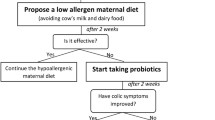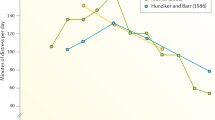Abstract
Context
Infantile colic is self-limiting condition but it can be a cause of anxiety for parents and challenge for doctors. The challenge for the doctors lies in correct identification of the condition and appropriate management. The objective of this review article is to summarize the pathophysiology, treatment options and outcome in infantile colic so that clinicians can have a fair idea about the condition, recent updates and future prospects.
Evidence
A search of the Cochrane Library, PubMed, and Google Scholar was made using the key words “Infant colic”, Infantile colic”, “excessive crying in infants”. All the materials were analyzed and summarized.
Results
At present, infantile colic is an area of clinical research both in terms of etiology and treatment. Various etiological theories have been proposed but none of them are strong enough to completely describe the condition. Various treatment agents are being tried for colic like counseling and behavioral modification, dietary modification, lactase and probiotic supplementation, pain relieving agents, and chiropathy. Proper counseling of the parents is the first line of management at present. Simethicone has no role in decreasing the symptoms of colic and Dicyclomine is not recommended in children younger than six months. No specific recommendations have been made on the use of pain relieving agents and manipulative therapies in colic. At present strong evidence is lacking regarding the use of probiotics, lactase supplementation and dietary modification.
Conclusion
Counseling of parents about the benign nature of the condition is considered first line for now until an effective treatment is established. Other treatment options are prescribed on a case-based manner, and based on the parental perception of the condition.
Similar content being viewed by others
References
Barr RG. The normal crying curve: what do we really know? Dev Med Child Neurol. 1990;32:356–62.
Wessel MA, Cobb JC, Jackson EB, Harris GS Jr, Detwiler AC. Paroxysmal fussing in infancy, sometimes called colic. Pediatrics. 1954;14:421–35.
van Tilburg MA, Rouster A, Silver D, Pellegrini G, Gao J, Hyman PE. Development and validation of a Rome III functional gastrointestinal disorders questionnaire for infants and toddlers. J Pediatr Gastroenterol Nutr. 2016;62:384–6.
Zeevenhooven J, Koppen IJ, Benninga MA. The new Rome IV criteria for functional gastrointestinal disorders in infants and toddlers. Pediatr Gastroenterol Hepatol Nutr. 2017;20:1–13.
Vandenplas Y, Abkari A, Bellaiche M, Benninga M, Chouraqui JP, Çokura F, et al. Prevalence and health outcomes of functional gastrointestinal symptoms in infants from birth to 12 months of Age. J Pediatr Gastroenterol Nutr. 2015;61:531–7.
Steutel NF, Benninga MA, Langendam MW, de Kruijff I, Tabbers MM. Reporting outcome measures in trials of infant colic. J Pediatr Gastroenterol Nutr. 2014;59:341–6.
Lucassen PL, Assendelft WJ, van Eijk JT, Gubbels JW, Douwes AC, van Geldrop WJ. Systematic review of the occurrence of infantile colic in the community. Arch Dis Child. 2001;84:398–403.
Canivet C, Hagander B, Jakobsson I, Lanke J. Infantile colic–less common than previously estimated? Acta Paediatr. 1996;85:454–8.
Høgdall CK, Vestermark V, Birch M, Plenov G, Toftager-Larsen K. The significance of pregnancy, delivery and postpartum factors for the development of infantile colic. J Perinat Med. 1991;19:251–7.
Van Tilburg MA, Hyman PE, Walker L, Rouster A, Palsson OS, Kim SM, Whitehead WE. Prevalence of functional gastrointestinal disorders in infants and toddlers. J Pediatr. 2015;166:684–9.
Liu W, Xiao LP, Li Y, Wang XQ, Xu CD. Epidemiology of mild gastrointestinal disorders among infants and young children in Shanghai area. Zhonghua Er Ke Za Zhi. 2009; 47:917–21 [Chinese].
Hide DW, Guyer BM. Prevalence of infant colic. Arch Dis Child. 1982;57:559–60.
Wal MF, Boom DC, Pauw-Plomp H, de Jonge GA. Mothers’ reports of infant crying and soothing in a multicultural population. Arch Dis Child. 1998;79:312–7.
Talachian E, Bidari A, Rezaie MH. Incidence and risk factors for infantile colic in Iranian infants. World J Gastroenterol. 2008;14:4662–6.
Chogle A, Velasco-Benitez CA, Koppen IJ, Moreno JE, Ramírez Hernández CR, Saps Population based study on the epidemiology of functional gastrointestinal disorders in young children. J Pediatr. 2016;179:139–43.
Rubin SP, Prendergast M. Infantile colic: incidence and treatment in a Norfolk community. Child Care Health Dev. 1984;10:219–26.
Paradise JL. Maternal and other factors in the etiology of infantile colic report of a prospective study of 146 infants. JAMA. 1966;197:191–9.
Gelfand AA. Infant colic. Semin Pediatr Neurol. 2016; 23:79–82.
Ghoshal UC. How to interpret hydrogen breath tests. J Neurogastroenterol Motil. 2011;17:312–7.
Hyams JS, Geertsma MA, Etienne NL, Treem WR. Colonic hydrogen production in infants with colic. J Pediatr. 1989;115:592–4.
Illingworth. Infantile colic revisited. Arch Dis Child. 1985;60:981-5.
Miller JJ, McVeagh P, Fleet GH, Petocz P, Brand JC. Breath hydrogen excretion in infants with colic. Arch Dis Child. 1989;64:725–9.
Abdo-Bassols F, Lifshitz F, Del Castillo ED, Martinez-Garza V. Transient lactose intolerance in premature infants. Pediatrics. 1971;48:816–21.
Leibman WM. Infantile colic. Association with lactose and milk intolerance. JAMA. 1981;245:732–3.
Savino F, Cresi F, Pautasso S, Palumeri E, Tullio V, Roana J, et al. Intestinal microflora in breastfed colicky and noncolicky infants. Acta Paediatr. 2004;93:825–9.
de Weerth C, Fuentes S, de Vos WM. Crying in infants: on the possible role of intestinal microbiota in the development of colic. Gut Microbes. 2013;4:416–21.
Ali AS, Borei MB. Helicobacter pylori and Egyptian infantile colic. J Egypt Soc Parasitol. 2013;43:327–32.
Zeskind PS, Barr RG. Acoustic characteristics of naturally occurring cries of infants with “colic”. Child Dev. 1997;68:394–403.
Merkel SI, Voepel-Lewis T, Shayevitz JR, Malviya S. The FLACC: A behavioral scale for scoring postoperative pain in young children. Pediatr Nurs. 1997;23:293–7.
Taylor WC. A study of infantile colic. Can Med Assoc J. 1957;76:458–61.
Clifford TJ, Campbell MK, Speechley KN, Gorodzinsky F. Infant colic: empirical evidence of the absence of an association with source of early infant nutrition. Arch Pediatr Adolesc Med. 2002;156:1123–8.
Ali A. Infantile colic, is there an association with the source of early infant nutrition? Int J Pediatr Health Care Advancements. 2017;101:24–8.
Garg P. Infantile colic-Unfolded. Indian J Pediatr. 2004;71:903–6.
Cetinkaya B, Baºbakkal Z. A validity and reliability study investigating the Turkish version of the Infant Colic Scale. Gastroenterol Nurs. 2007;30:84–90.
Marqués GS, Martínez CR, González Zapata S, Rebollo Salas M, Jiménez Rejano JJ. Tools assessment and diagnosis to infant colic: a systematic review. Child Care Health Dev. 2017;43:481–8.
Barr RG, Kramer MS, Boisjoly C, McVey-White L, Pless IB. Parental diary of infant cry and fuss behaviour. Arch Dis Child. 1988;63:380–7.
Clifford TJ, Campbell MK, Speechley KN, Gorodzinsky F. Sequelae of infant colic evidence of transient infant distress and absence of lasting effects on maternal mental health. Arch Pediatr Adolesc Med. 2002;156:1183–8.
Cirgin Ellett ML, Murphy D, Stroud L, Shelton RA, Sullivan A, Ellett SG, et al. Development and psychometric testing of the infant colic scale. Gastroenterol Nurs. 2003;26:96–103.
Freedman SB, Al-Harthy N, Thull-Freedman J. The crying infant: Diagnostic testing and frequency of serious underlying disease. Pediatrics. 2009;123:841–8.
Biagioli E, Tarasco V, Lingua C, Moja L, Savino F. Painrelieving agents for infantile colic. Cochrane Database Syst Rev. 2016;16;9:CD009999.
Dobson D, Lucassen PL, Miller JJ, Vlieger AM, Prescott P, Lewith G. Manipulative therapies for infantile colic. Cochrane Database Syst Rev. 2012;12:CD004796.
Thomas MR, Gordon M, Banks SSC, Wallace C. Parent training programmes for managing infantile colic (Protocol). Cochrane Database Syst Rev. 2016;12:CD012459.
Savino F, Tarasco V, Sorrenti M, Lingua C, Moja L, Gordon M, et al. Dietary modifications for infantile colic (Protocol). Cochrane Database Syst Rev. 2014;3:CD011029.
Banks SSC, Thomas MR, Gordan M, Wallace C, Alobeng AK. Probiotics to prevent infantile colic (Protocol). Cochrane Database Syst Rev. 2016;12:CD012473.
Praveen V, Praveen G, Deshpande G, Patole SK. Oral probiotics for infantile colic (Protocol). Cochrane Database Syst Rev. 2014; CD010986.
Dihigo SK. New strategies for the treatment of colic: Modifying the parent/infant interaction. J Pediatr Health Care. 1998;12:256–62.
Taubman B. Parental counseling compared with elimination of cow’s milk or soy milk protein for the treatment of infant colic syndrome: A randomized trial. Pediatrics. 1988;81:756–61.
Barr RG, Rajabali F, Aragon M, Colbourne M, Brant R. Education about crying in normal infants is associated with a reduction in pediatric emergency room visits for crying complaints. J Dev Behav Pediatr. 2015;36:252–7.
Kanabar D, Randhawa M, Clayton P. Improvement of symptoms in infant colic following reduction of lactose load with lactase. J Hum Nutr Diet. 2001;14:359–63.
Kearney PJ, Malone AJ, Hayes T, Cole M, Hyland M. A trial of lactase in the management of infant colic. J Hum Nutr Diet. 1998;11:281–5.
Anabrees J, Indrio F, Paes B, AlFaleh K. Probiotics for infantile colic: A systematic review. BMC Pediatr. 2013;13:186.
Savino F, Cordisco L, Tarasco V, Palumeri E, Calabrese R, Oggero R, et al. Lactobacillus reuteri DSM 17938 in infantile colic: A randomized, double-blind, placebocontrolled trial. Pediatrics. 2010;126:526–33.
Szajewska H, Gyrczuk E, Horvath A. Lactobacillus reuteri DSM 17938 for the management of infantile colic in breastfed infants: A randomized, double-blind, placebocontrolled trial. J Pediatr. 2013;162:257–62.
Savino F, Pelle E, Palumeri E, Oggero R, Miniero R. Lactobacillus reuteri (American Type Culture Collection Strain 55730) versus simethicone in the treatment of infantile colic: A prospective randomized study. Pediatrics. 2007;119:124–30.
Sung V. Probiotic interventions in infantile colic. Curr Opin Clin Nutr Metab Care. 2015;18:307–11.
Koletzko S, Niggemann B, Arato A, Dias JA, Heuschkel R, Husby S, et al. European Society of Pediatric Gastroenterology, Hepatology, and Nutrition. Diagnostic Approach and Management of Cow’s-milk Protein Allergy in Infants and Children: ESPGHAN GI Committee Practical Guidelines. J Pediatr Gastroenterol Nutr. 2012;55:221–9.
Vandenplas Y, Ludwig T, Bouritius H, Alliet P, Forde D,. Peeters S, et al. Randomised controlled trial demonstrates that fermented infant formula with short chain galacto oligosaccharides and long chain fructo oligosaccharides reduces the incidence of infantile colic. Acta Paediatr. 2017;106:1150–8.
Jain K, Gunasekaran D, Venkatesh C. Gripe water administration in infants 1–6 months of age-A crosssectional study. J Clin Diagn Res. 2015;9:6–8.
Vandenplas Y, Rudolph CD, Di Lorenzo C, Hassall E, Liptak G, Mazur L, et al. Pediatric Gastroesophageal Reflux Clinical Practice Guidelines: Joint Recommendations of the North American Society for Pediatric Gastroenterology, Hepatology, and Nutrition (NASPGHAN) and the European Society for Pediatric Gastroenterology, Hepatology, and Nutrition (ESPGHAN). J Pediatr Gastroenterol Nutr. 2009;49:498–547.
Author information
Authors and Affiliations
Corresponding author
Rights and permissions
About this article
Cite this article
Sarasu, J.M., Narang, M. & Shah, D. Infantile Colic: An Update. Indian Pediatr 55, 979–987 (2018). https://doi.org/10.1007/s13312-018-1423-0
Published:
Issue Date:
DOI: https://doi.org/10.1007/s13312-018-1423-0




